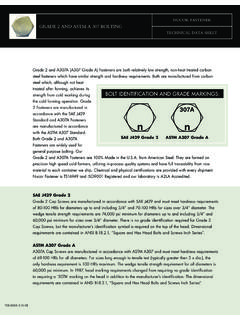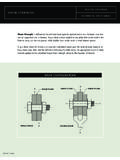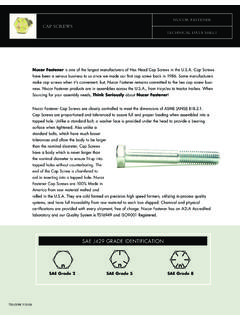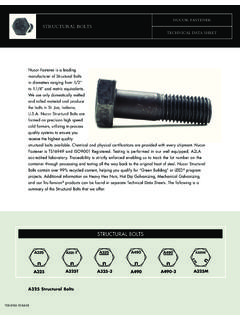Transcription of nuCor fastEnEr turn-of-nut installation
1 turn -of-nut installationtECHniCal Data sHEEtnuCor fastEnErTurn-of-Nut installation is one of four installation methods recognized by the Research Council on Structural Connections, RCSC, for installing Structural Bolts. When installations require pretensioned or slip-critical joints and hex head structural bolts are being utilized, this installation method results in more uniform bolt pretensions than is generally obtained with other torque-control methods. Combined with the Pre- installation Verification Procedure listed below, the turn -of-Nut installation method will give your installation a proven method to achieve all of your installation requirements without torque wrenches and calibration concerns. installation is as easy as 1-2-3 after Pre- installation Verification Testing; 1. Snug-tighten the bolts in the joint; 2. Match-mark the nut and protruding end of the bolt; and 3. Rotate the nut by the proper amount listed in the table below.
2 Rotations Tolerance: For 1/3 turn (120 degrees) 30 degrees For 1/2 turn (180 degrees) 30 degrees For 2/3 turn (240 degrees) 45 degrees Snug Tight = The tightness that is required to bring the plies into firm contact (Typically obtained with a few impacts of an impact wrench or the full effort of an Iron-worker using an ordinary spud wrench).Bolts used in the Snug-Tightened Condition do not require Pre- installation Verification turn the nut during installation if you have the turn the same element during testing as you plan to turn during 2-18-08 Flat Surfaces under Bolt Head and Nut BolT DIameTeR(INches)BolT leNgThTo 4D RequIReD TuRNsBolT leNgThoveR 4D To 8D RequIReD TuRNsBolT leNgThoveR 8D To 12D RequIReD TuRNs1/ 2 "2"1/3 turn >2 to 4"1/2 turn >4 to 6"2/3 turn5/8 " "1/3 turn > to 5"1/2 turn >5 to "2/3 turn3 /4 "3"1/3 turn >3 to 6"1/2 turn >6 to 9"2/3 turn7/ 8 " "1/3 turn > to 7"1/2 turn >7 to "2/3 turn1"4"1/3 turn >4 to 8"1/2 turn >9 to "2/3 turn1 1/8" "1/3 turn > to 9"1/2 turn >10 to 15"2/3 turn1 1/4"5"1/3 turn >5 to 10"1/2 turn >11 to "2/3 turnTurn-of-nuT MeThod required Turns for PreTensioning froM snug-TighT(Information from RCSC Table )PO Box 6100 | St.
3 Joe, Indiana 46785 | ph: (800) 955-6826 or (260) 337-1726 | fax: (260) 337-1726 | verification Procedure for turn -of-Nut installation method1. Take 3 bolts of each diameter, length, grade and production lot; 3 washers of each diameter and production lot; and 3 nuts of each diameter, grade and production lot as they will be Assemble the first set of bolt-washer-nut combination into the Skidmore-Wilhelm. 3. Snug the assembly using the same technique to be used in the structure. 4. Match mark the nut, bolt and Skidmore faceplate. 5. Apply the required rotation as listed in the above table for the assembly being tested. 6. Verify that the tension on the Skidmore dial gage is at least 5% more than the min. bolt pretension as listed in the table below. 7. Record the tension achieved in a log book. 8. Remove the assembly and repeat steps 2 through 7 until three assemblies have been tested.
4 Information from the RCSC Specification for Structural Joints Using ASTM A325 or A490 Bolts ToDaY, ThaT lITTle n meaNs BIg T hIN gs! This Technical Data Sheet is subject to change without prior and required TurnsBolTDIameTeR asTm a325 BolTs aNDF1852 assemBlIesasTm a490 BolTs aNDF2280 assemBlIes(inches)(kips)a+ 5% (kips)(kips)a+ 5% (kips) 1 5 3 7 1 1 3 1 Values from RCSC Table 1 kip = 1,000 poundsMinimum Bolt Pretension for Pretensioned and Slip-Critical JointsMatchmarkingRequired TurnsNutBolt EndSteel2/3 turn - 240 1/2 turn - 180 1/3 turn - 120



